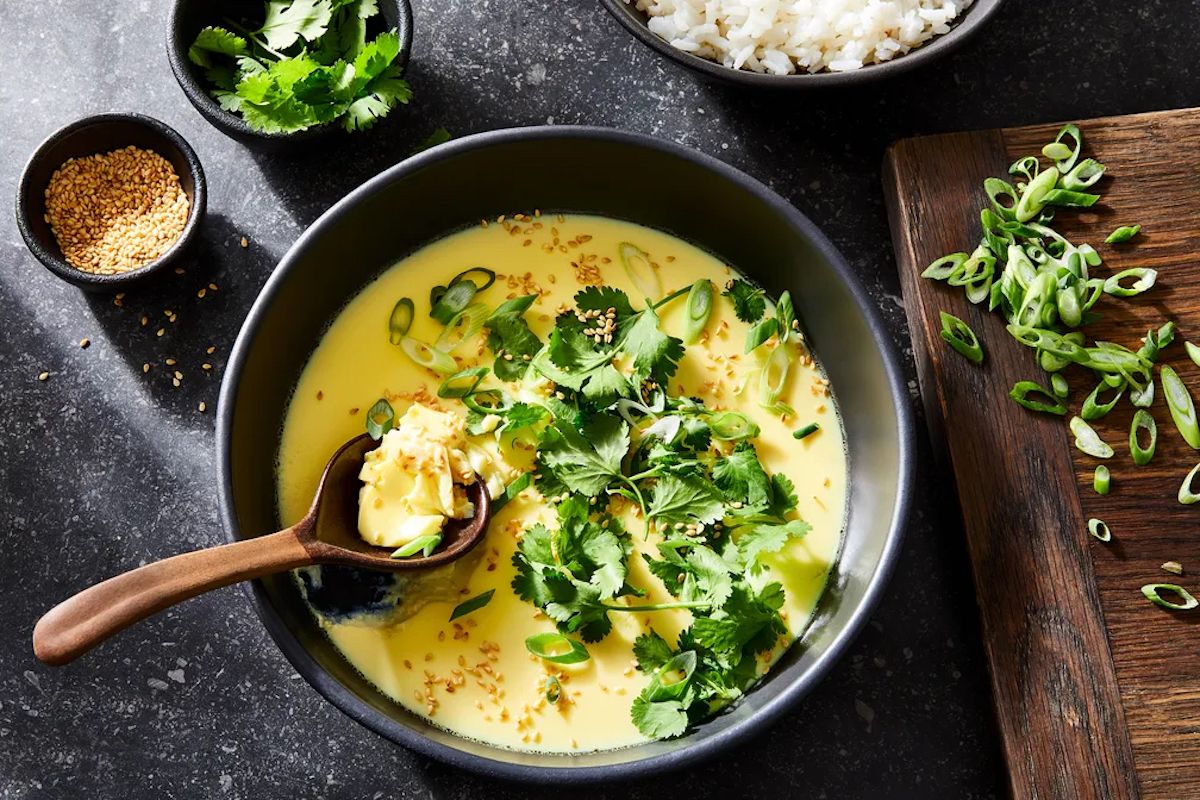Big Little Recipe has the smallest-possible ingredient list and big everything else: flavor, creativity, wow factor. That means five ingredients or fewer — not including water, salt, black pepper, and certain fats (like oil and butter), since we're guessing you have those covered. This week, guest columnist (and best-selling author! and hummus genius!) Hetty McKinnon is sharing a nostalgic, magical dish from her newest cookbook, To Asia, With Love.
* * *
Of all the dishes from my childhood that I have tried to re-create, this three-ingredient steamed egg custard, or shui dan as we call it in Cantonese, has been one of the trickiest for me to master. And to think, two of those ingredients are water and salt.
When I first embarked on this custard, I set myself up to succeed. I shipped over to New York the very dish that my mum used to make her steamed eggs. I FaceTimed her countless times, fastidiously coaxing a recipe.
Of course, as is often the case with Asian mothers, there was no recipe, just a narrative around what not to do, rather than measurements or timings. She shared a lot of seemingly superfluous details like "make sure you use cooled, boiled water" and "steam it on a very, very low heat."
I've got this, Mum, I know how to steam.
Turns out, I didn't. Where my mother's steamed water egg custard was silky and light, mine was puffy and pockmarked. Hers was the texture of a newborn's skin, mine more reminiscent of a wrinkly face. When I called my mum to troubleshoot, she asked me two key things: Did you use cooled, boiled water? No. And steam it on very low heat? Um...no again.
Sometimes the difference between good and spectacular is in the details. Especially when it comes to few-ingredient recipes. My mother's suggestion of "cooled, boiled water" was her way of telling me to use tepid water. A smooth, slippery texture is key to this dish, and the temperature of lukewarm water actually helps it combine with the egg. The water should not be hot at all; it should be warm, similar to bathwater.
Steaming is one of the tenets of Cantonese cooking, and while it is one of the simpler ways to cook, for dishes that call for delicacy and precision, it requires attention. Controlling the temperature is key. I'll make this easy for you—for this recipe, use the lowest heat setting you have (I cook with a gas stovetop, so perhaps this will be different on an electric hob). Some say to cover your eggs with foil to prevent water droplets falling onto the eggs, marring their silky surface, but personally, I don't find this step necessary.
Another helpful tip is to make sure your eggs are smooth and well beaten, but not so beaten that they have too many air bubbles — you can break up any clumps or slimy egg whites by pouring the mixture through a fine-mesh strainer.
There are many varieties of savory egg custards in Asian cultures. Japanese chawanmushi is a magical custard-soup hybrid that is made with dashi stock, while Korean gyeranjjim is similar, with a more soufflé-like finish. The Chinese version can be dressed up or down, depending on your mood. A simple topping is soy sauce, sesame oil, and sliced scallions or cilantro. You could also try ginger-scallion oil or an aromatic chile crisp. Or enjoy it unadorned.
In the end, the quest to perfect this Big Little Recipe taught me a great deal: the importance of listening, the power of patience, and that Mum is always right.
***
Recipe: Steamed "Water Egg" Custard
Prep time: 10 minutes
Cook time: 10 minutes
Serves: 1 to 4
Ingredients:
- 2 large eggs
- 1/2 cup (125 milliliters) boiled water, cooled until it's just warm (not hot) to the touch
- 1/2 teaspoon sea salt
- Rice, for serving
- Sliced scallions, fresh cilantro leaves, toasted sesame oil, or toasted white sesame seeds, for topping (optional)
Directions:
- Beat the eggs in a mixing bowl until the whites and yolks are completely blended. Place the bowl on a tea towel (to stop it from moving around) and slowly add the water in a steady stream, whisking constantly. Add the sea salt and whisk vigorously until the mixture is very well combined.
- Place a steaming rack or trivet in a saucepan (make sure it will hold the bowl you will steam the custard in), then add water until it is just underneath the rack. Bring the water to the boil.
- Pour the egg mixture through a sieve into a shallow heatproof bowl (the one I use is about 7 inches wide). Once the water has reached a rolling boil, place the bowl on the steaming rack or trivet. Cover with a lid, and immediately reduce the heat to the lowest temperature possible.
- Allow to steam for about 10 minutes, then lift the lid to see if the egg has set in the middle. If not, cover again and steam for another minute or so until it is set with a slight wobble. When the egg is ready, turn off the heat and leave the egg to sit, covered, for 5 minutes before removing.
- Serve warm just as is, or with your chosen toppings, but always with rice.
This post contains products independently chosen (and loved) by Food52 editors and writers. As an Amazon Associate, Food52 earns an affiliate commission on qualifying purchases of the products we link to.




Shares